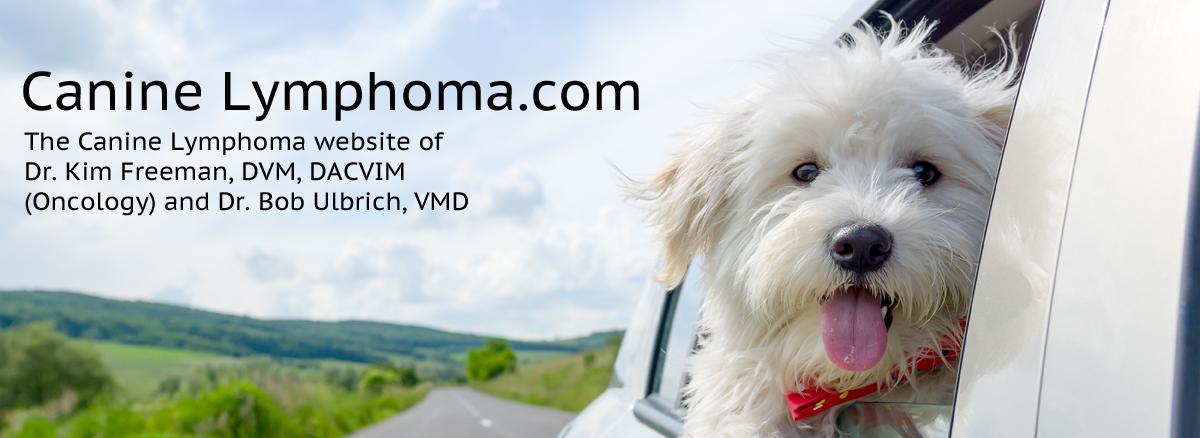 Canine Lymphoma is a broad term that describes any type of cancer that affects Lymphocytes. However, there are actually many different Canine Lymphoma Types, with the primary types generally classified by the area the body primarily affected.
Canine Lymphoma is a broad term that describes any type of cancer that affects Lymphocytes. However, there are actually many different Canine Lymphoma Types, with the primary types generally classified by the area the body primarily affected.
Because Lymphocytes are found throughout the body, all types of Canine Lymphoma are considered to be “systemic” – that is, affecting the body as a whole (as opposed to cancers that only affect some localized part) – even though some types of Canine Lymphoma may, in fact, be localized.
Specific Canine Lymphoma Types
Multicentric Lymphoma
By far, the most common of the Canine Lymphoma Types is “Multicentric Lymphoma,” which means the cancer affects lymph nodes located throughout the patient’s body.
Other less common Lymphomas in dogs include:
- Cutaneous Lymphoma (lymphoma of the skin – also known as Mycosis Fungoides or Epitheliotrophic Lymphoma)
- Alimentary or Gastrointestinal Lymphoma (lymphoma of the stomach and/or intestines); and
- Mediastinal Lymphoma (lymphoma involving lymph nodes within the chest or the thymus gland, etc.).
As noted on the Canine Lymphoma Symptoms page, the primary symptoms shown by patients generally reflect the organ or portion of the body affected by the cancer.
T Cell Lymphoma vs. B Cell Lymphoma
Within each of the Canine Lymphoma Types, there are 2 Lymphoma sub-types (or “Phenotypes”) that veterinarians primarily focus on – “B-Cell Lymphoma” and “T-Cell Lymphoma.”
Historically, data has shown that the vast majority of Canine Lymphomas diagnosed in dogs is “B-Cell Lymphoma” – which is great news, because statistically, dogs with B-Cell Lymphoma tend to respond much more favorably to available conventional treatments, both in terms of the percentage of patients who go into remission, and the length of the potential remission for those dogs who enter remission.
On the other hand, T-Cell Lymphoma tends to be much more resistant to the conventional dog cancer treatments currently available, and dogs who are diagnosed with T-Cell Lymphoma tend to have significantly less favorable conventional treatment results.
 As a result, sometimes the decision about the types of treatments caregivers give their dog (or whether to treat the disease at all) can depend on the type, or phenotype, of the cancer diagnosed. For example, in some cases, caregivers will choose not to treat dogs diagnosed with T-Cell Lymphoma (because of the statistical lower effectiveness of treatments in those cases).
As a result, sometimes the decision about the types of treatments caregivers give their dog (or whether to treat the disease at all) can depend on the type, or phenotype, of the cancer diagnosed. For example, in some cases, caregivers will choose not to treat dogs diagnosed with T-Cell Lymphoma (because of the statistical lower effectiveness of treatments in those cases).
And while we generally recommend that caregivers do SOMETHING to care for their dogs (regardless of the type of cancer they’re diagnosed with), we understand that this information on expected prognosis can certainly affect the types and levels of treatment that patients may ultimately choose.
Other Canine Lymphoma Types
Note: Despite the focus on these 2 primary Canine Lymphoma phenotypes, most cancer vets believe that there are actually many more Canine Lymphoma phenotypes – 100s of them perhaps – based on molecular analysis of the markers, classifications, and subtypes of Lymphocytes.
This belief is based on the fact that human Lymphoma researchers have identified hundreds of different Lymphoma “types” and many vets believe that many of these human Lymphoma sub-types likely exist in our pets as well.
However, this lack of detailed distinction into specific Canine Lymphoma phenotypes is of less concern given our currently limited Canine Lymphoma options. For now, greater knowledge about multiple phenotypes likely would not have any significant change in recommended treatment protocols for dogs affected by the disease (although this information could, in certain cases, affect the expected prognosis and of the potential effectiveness of certain treatments under consideration). Hopefully, someday we’ll have more targeted therapies for each phenotype that will lead to better personalized Canine Lymphoma care.
So instead, vets tend to focus on the two primary Canine Lymphoma sub-types identified to date – B-Cell Lymphoma and T-Cell Lymphoma – and take their actions from there.
Canine Leukemia
One other specific Canine Lymphoma type that needs to be discussed is Canine Leukemia.
 By definition, Leukemia means there are cancerous cells in the blood. Lymphoma means there are cancerous cells in organ tissues. Patients can have both phases of disease: leukemia and lymphoma. For example: a patient with Stage V Canine Lymphoma is a patient with leukemic lymphoma, meaning the cancer is both in organ tissue and in the bone marrow or blood. However, patients can have leukemia without having lymphoma, which means it is just in the bone marrow, but not in organs.
By definition, Leukemia means there are cancerous cells in the blood. Lymphoma means there are cancerous cells in organ tissues. Patients can have both phases of disease: leukemia and lymphoma. For example: a patient with Stage V Canine Lymphoma is a patient with leukemic lymphoma, meaning the cancer is both in organ tissue and in the bone marrow or blood. However, patients can have leukemia without having lymphoma, which means it is just in the bone marrow, but not in organs.
Statistically, Leukemia is pretty rare for dogs, although some patients may be diagnosed with BOTH Canine Leukemia and Lymphoma. In fact, this is technically the definition of “Stage 5 Canine Lymphoma” as discussed in the section on Canine Lymphoma Stages.
Recommended treatment protocols for patients with Canine Leukemia vs. Canine Lymphoma are essentially identical, but unfortunately the success rate for treating patients with Canine Leukemia (both in terms of the likelihood of remission and the potential length of remission) is significantly worse than the prognosis for other Canine Lymphoma patients.
Note: There are high grade and low grade forms of lymphoma and leukemia, and distinctions should be made between lymphoid and myeloid leukemias. Lymphoid leukemias are derived from lymphocytes and myeloid leukemias derived from other types of white blood cells. The prognosis for “low grade leukemia” (also called small cell leukemia or chronic lymphocytic leukemia) is relatively good, and it is a treatable disease with a prognosis often equal to or greater than 2 years in duration. This is vastly different than the prognosis for “acute lymphoblastic leukemia” or a “high grade lymphoblastic leukemia” which has a very poor prognosis. We use the term lymphocytic for low grade disease and lymphoblastic for high grade disease. These terms refer to the cell size and maturity.
- Previous Article – Canine Lymphoma Home
- Next Article – Canine Lymphoma Causes
For more free Canine Lymphoma information, downloads and support - and
for help with your dog’s cancer care – visit our sister Charity website
"The Dog Cancer Tribe" at www.DogCancerTribe.com
Note: The information on this website is intended for research and informational purposes only. It is not to be used to diagnose or treat any disease, and should not be used as a substitute for proper veterinary consultation and care. Every dog and every cancer case is different, so if you fear that your dog has Canine Lymphoma, we encourage you to seek appropriate professional veterinary care as quickly as possible to determine the best course of action to treat your dog and his or her particular circumstances.
———————
| (c) 2021 - CanineLymphoma.com | Privacy Policy | Terms and Conditions | Sitemap |





